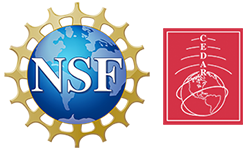2025 Workshop: Geospace Model-Data Comparisons
Emma Spanswick
Gareth Perry
Anthony Sciola
Adam Michael
Dong Lin
Haonan Wu
Tianyang Hu
Wenbin Wang
Liying Qian
Qian Wu
Yongliang Zhang
During geomagnetic storms, the magnetosphere-ionosphere-thermosphere (MIT) system becomes energized and engages in complex, multi-scale interactions between the physical domains. Mesoscale processes, both singularly and collectively, can profoundly impact the global evolution of the geospace system. This is particularly true in the magnetosphere’s nightside transition region as well as the low and mid-latitude ionosphere-thermosphere region that it maps to. Recent advances in the resolving power and coupling complexity of global geospace modeling have enabled investigations into the drivers and impacts of these phenomena. In order to understand the system-level behavior of storm-time geospace it is necessary to combine observational data in various forms with global models in ways that both validate the models and use them to contextualize the observations.
The NASA DRIVE Center for Geospace Storms (CGS) aims to develop a physics-based, predictive community model of storm-time geospace that couples all key regions while resolving critical mesoscale processes. The extensive network of in-situ and ground-based instrumentation across the MIT system provides a valuable foundation for improving data-model comparisons. However, leveraging these observational resources effectively requires a strategic approach and sustained collaboration between the modeling and data communities, as well as the development of methods to validate the system-level behavior of geospace models.
This workshop will focus on the key question: How can we best utilize existing observational data to develop robust, quantitative methods for model validation and comparison to assess how well the models reproduce the characteristic behavior of the system? As part of an ongoing collaboration between CGS and the GEM MESO focus group, this session will engage both the GEM and CEDAR communities in this endeavor. We aim to bring together the modeling and data communities to foster discussions on best practices, current challenges, and future opportunities for advancing geospace model/data comparisons, which is key to using simulations to understand the physical processes driving the system.
Modeling efforts and observational analyses are inseparable parts of atmosphere-ionosphere studies. It is common for modelers to validate their model results against observational evidence, while data analysts seek help from first-principles models to interpret measurements and the underlying physical processes. However, due to insufficient communication, researchers in their respective fields may sometimes miss contemporary advances outside their area of expertise. For example, a data synthesis method originally developed for rainfall distribution might serve as a useful tool for auroral data assimilation. Additionally, local refinement of numerical models lays the foundation for one-to-one comparisons with local ground-based and space-borne observations. These topics are not limited to multi-scale processes in the atmosphere-ionosphere system but can also include coupling processes (top-down and bottom-up) and both long-term and short-term variations. This session will feature short presentations and open discussions, providing an engaging environment for modelers and data scientists to introduce and promote their methodologies and data products. At the same time, new collaborations may be fostered around specific scientific topics. Graduate students and early-career scientists are highly encouraged to present their work in this session.
This session will consist of brief ~10 minute talks, followed by a community discussion. The tentative agenda is as follows:
- Katherine Cariglia and Bill Rideout (MIT Haystack): Use of Madrigal database
- Dong Lin (NCAR/HAO): SAID simulations
- Prakash Poudel (Clemson University): Lattice Kriging and TIEGCM simulation
- Anthony Sciola (JHU/APL): SAR arc simulations
- Jingyuan Feng (Wuhan University): VLF dataset and examples
- Anusree Devanandan (UNH): BBF characteristics
- Eric Donovan (University of Calgary): The Transition Region Explorer (TREx) datasets and capabilities
- Joel Tibbetts (UNH): ENA OSSE
- Haonan Wu (NCAR/HAO): TIEGCM-NG
For virtual participation, please use the login details below:
https://ucar-edu.zoom.us/j/93943280647?pwd=XaBcd1MDGfxjT0V4K5iHwHjM2kxT…
Meeting ID: 939 4328 0647
Passcode: CEDAR2025
This workshop is part of an ongoing discussion series hosted by the MESO Focus Group in collaboration with CGS. It provides a platform for exploring data and modeling challenges across the entire geospace system, from the thermosphere to the magnetosphere.
This session is particularly valuable for both the modeling and observational communities as we work toward answering a key scientific question: How can we leverage currently available data to develop quantitative methods for model validation and comparison?
The session will feature short presentations followed by time for open discussion, fostering collaboration and idea-sharing among participants.
Science advances through communication and collaboration. Typically, we seek potential collaborations when faced with specific scientific questions. However, with the growth of various models and the accumulation of massive data over the past few decades, effectively and efficiently pinpointing the correct model(s) or dataset has become an increasingly important task in scientific research. For example, distributed ground-based instruments like the Fabry-Perot Interferometer provide valuable thermospheric wind measurements. Yet, modelers may be unaware of these data sources, missing the opportunity to use them for model validation. In this session, we aim to provide a platform for researchers to share their state-of-the-art models and newly calibrated datasets, enabling participants to be more informed and more easily achieve their targeted scientific objectives.
On the other hand, researchers sometimes fail to realize that their work can have an even greater impact on others’ research. Often, a "side product", such as a simple model developed to study a specific physical process or a methodology used to analyze a particular dataset, becomes a powerful tool for studying other atmosphere-ionosphere processes or serves as a general strategy to analyze various types of data. As another well-known example, ensemble data assimilation was initially introduced to better constrain the initial conditions for weather forecast models. Today, it has become the de facto standard approach for assimilating physical models in the atmosphere-ionosphere system. In this session, we will focus on promoting models, methodologies, and datasets, regardless of whether they are tied to specific scientific questions, allowing participants the freedom to apply them to various scientific tasks.
MESO, Bea Gallardo-Lacourt
